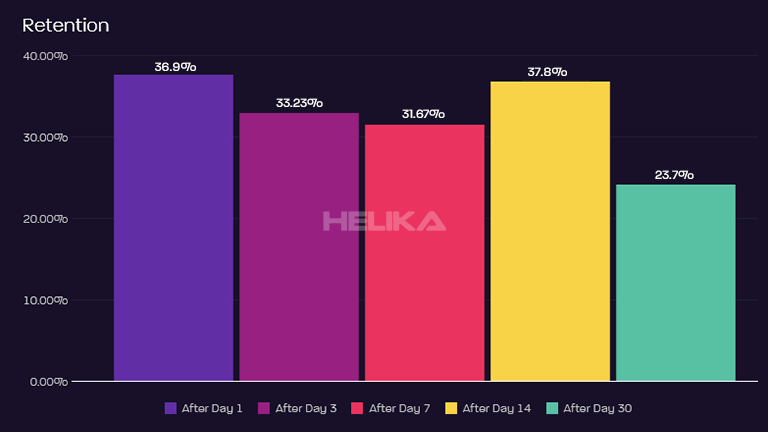Hyper-casual games are designed to reach a wide audience but that doesn’t mean they are easy to create. In fact, creating a successful hyper-casual game requires the right balance of gameplay mechanics, user engagement, and monetization strategies.
In this guide, we will cover the most effective hyper-casual game mechanics that can make or break your game’s success. From simple swerving mechanics to engaging experiences, these mechanics play a crucial role in player retention and monetization strategies.
#1 – Timing Mechanics: Perfect Tap for Instant Gratification
One of the most popular hyper-casual game mechanics is based on timing. These games require players to tap or swipe at the right moment to achieve a specific goal. This creates a sense of instant gratification for the player, as they are rewarded immediately for their actions.
Timing mechanics have become increasingly popular in recent years with the rise of hyper-casual puzzle games such as “Flappy Bird” and “Temple Run.” These games require precise timing to navigate through obstacles and achieve a high score. The pressure to perfectly time each tap keeps players engaged for longer periods, resulting in higher retention rates.
#2 – Idle Mechanics: Tap and Wait for Progression
Idle mechanics are another popular feature in hyper-casual games. These mechanics require players to tap or swipe occasionally, but the majority of gameplay is automated. Players can progress through the game without actively playing, allowing them to continue making progress even when they are not actively engaged.
This mechanic is beneficial for player retention as it offers a sense of progression without requiring constant attention. It also allows players to come back to the game at any time and see their progress, encouraging them to continue playing. Simulation games where players can build and upgrade their own virtual world often utilize idle mechanics.

#3 – Puzzle Mechanics: Challenge and Reward
Puzzle mechanics are common in hyper-casual games, where players must solve a series of challenges to progress. These challenges can range from simple puzzles to more complex ones that require strategic thinking.
The key to successful puzzle mechanics is balancing the difficulty level so that players feel challenged but not frustrated. Rewarding players with in-game currency or power-ups for solving a puzzle also adds another layer of motivation and engagement.

#4 – Simple Mechanics: Easy to Learn, Hard to Master
Many hyper-casual games have simple mechanics that are easy for anyone to pick up and play. This makes the games accessible to a wide audience and increases their potential for popularity.
However, these simple mechanics can also be deceivingly difficult, making players want to keep trying until they master the game. This creates a sense of accomplishment and satisfaction, making players more likely to continue playing and recommending the game to others.
Some games also introduce new elements or challenges as the player progresses, keeping the gameplay fresh and offering new levels of difficulty. Physicals and a clearly defined set of rules and objectives also contribute to the appeal of simple mechanics in hyper-casual games.
#5 – Swerve Mechanics: The Element of Surprise
Many hyper-casual games utilize swerve mechanics, where players must quickly react to unexpected obstacles or challenges. As a more fast paced gaming experience, these games require players to think quickly and make split second decisions, adding an element of surprise and excitement to the gameplay.
Swerve mechanics also offer a more dynamic experience as every round is different, keeping players on their toes and preventing the game from becoming too predictable or repetitive. These games are engaging but can be mentally exhausting, which adds to the challenge but can also cause too much stress for some players.
Having reasonable rest periods with some sort of laid back story telling, animation or dialogue might be good to help players recharge in between sessions.
#6 – Dexterity Mechanics: A Test of Skill
Dexterity mechanics, such as tapping and swiping, are commonly used in hyper-casual games to test players’ speed and accuracy. These mechanics require players to have good hand-eye coordination and quick reflexes, challenging their physical skills rather than just mental ones.
By adding accuracy to the timing aspect of these games, players are forced to focus and improve their skills with each round. This can create a sense of accomplishment as players understand that they are improving their skills rather than depending on randomness or luck. Fruit Ninja and Guitar Hero are great examples of games that use dexterity mechanics to create a fun and challenging experience.
Case Study #1 – Temple Run

Imagine being chased by a group of angry monkeys through an ancient temple, and your only option for survival is to run as fast as you can while avoiding obstacles along the way. This is the premise of Temple Run, a popular endless running game that utilizes swipe mechanics to navigate through its different challenges.
Players must constantly swipe left or right to change directions, the wrong move resulting in the player’s character falling off a cliff or getting caught by the monkeys. The fast-paced gameplay and increasing difficulty keep players engaged and constantly trying to beat their high score.
Temple Run creates a consistent running speed, so less factors are at play making the game more about reaction and reflexes. What changes is the speed of decision making when it comes to turning. Consider reducing the total number of controls while turning up other factors to increase difficulty, as hyper casual games require simplicity whilst the game becomes more challenging over time.
Case Study #2 – Flappy Bird

As a simple game that has reached mass appeal in shocking numbers, Flappy Bird is a testament to the power of simple mechanics. With just one tap required to make the bird flap and avoid obstacles, players were instantly hooked on trying to beat their highest score. The game’s minimalist design, combined with its addictive “just one more try” gameplay, kept players engaged for hours on end.
However, what made Flappy Bird truly stand out was its use of timing mechanics. Players needed to have precise timing and control to navigate the bird through narrow gaps, adding an extra level of challenge and excitement to the gameplay.
Much like Temple Run, difficulty in Flappy Bird increases as players progress, with obstacles becoming more frequent and challenging. This gradual increase in difficulty keeps players engaged and motivated to continue playing. As a game developer, consider the rate of increased difficulty in your hyper casual game to keep players challenged but not overwhelmed.
Using Analytics To Create a Successful Hyper-Casual Game
Even some of the best hyper-casual game mechanics out there right now can still be made better. With the correct data guiding your way, game developers are able to create the perfect hyper-casual game that will appeal to their target audience while still having addictive game play.
Often, these types of games simply encourage players to spend real money while banner ads or video ads are displayed. These additional moving pieces can cause the overall gameplay to suffer as a result so it’s important to find the right balance between monetization and enjoyable play. That’s where Helika comes in.
Helika is a game analytics platform that helps developers track, analyze, and optimize their hyper-casual games. By using Helika, developers can gain valuable insights on player behavior, level progression, and monetization strategies.
With these insights, exponential growth can be achieved as the friction and complexity is reduced. Monetization suggestions can help maximize earnings while gameplay edits can increase user retention. At Helika, we’ve proven our product after working with top Web3 game developers such as Maplestory, Ubisoft, Yuga Labs, Parallel and more.
If you’re developing a hypercasual game and would like to unlock the secrets to becoming the next big hit, consider utilizing the power of analytics with Helika. By contacting us, you can spend less time worrying about about data and more time building great games.
Final Thoughts
The mobile gaming industry has brought hyper-casual games to the masses and for good reason. As long as the core gameplay mechanics are exceptional, app developers can expect a large number of players entering into the fold. Now, it is your turn to use these game mechanics and strategies to create a successful hyper-casual game that will stand out in the market.
The key is to continuously innovate and engage players with unexpected twists, immersive experiences, and creative endeavors. Utilize analytics data and player feedback to constantly improve and refine your game. With the right combination of mechanics, engagement strategies, and monetization techniques, your hyper-casual game can become the next viral sensation.


